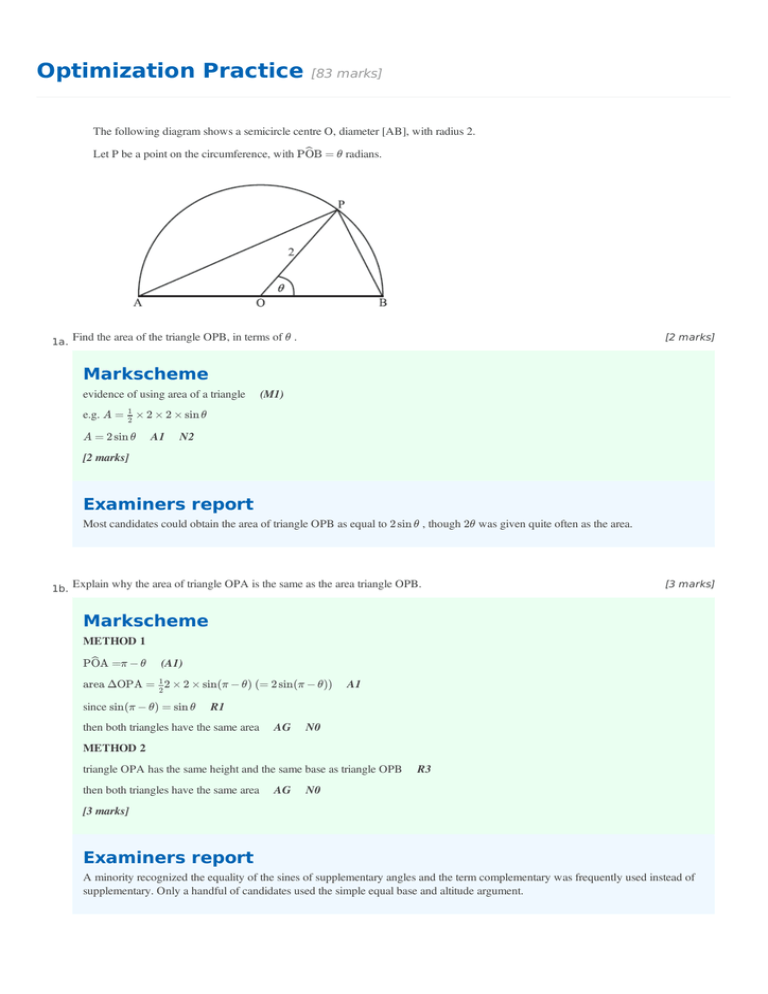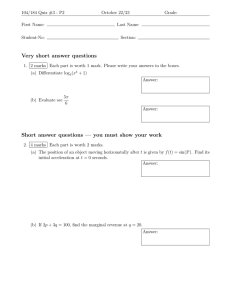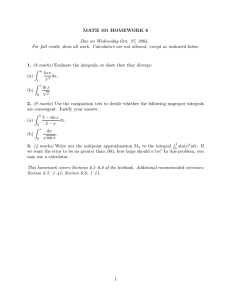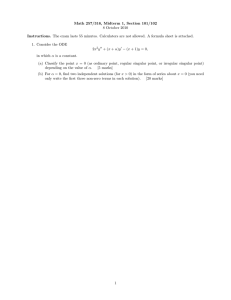IB Questionbank - Uplift Education
advertisement

Optimization Practice [83 marks] The following diagram shows a semicircle centre O, diameter [AB], with radius 2. Let P be a point on the circumference, with PÔB = θ radians. 1a. Find the area of the triangle OPB, in terms of θ . [2 marks] Markscheme (M1) evidence of using area of a triangle 1 2 e.g. A = × 2 × 2 × sin θ A = 2 sin θ A1 N2 [2 marks] Examiners report Most candidates could obtain the area of triangle OPB as equal to 2 sin θ , though 2θ was given quite often as the area. 1b. Explain why the area of triangle OPA is the same as the area triangle OPB. [3 marks] Markscheme METHOD 1 PÔA =π − θ (A1) area ΔOPA = 1 2 × 2 × sin(π − θ) 2 since sin(π − θ) = sin θ (= 2 sin(π − θ)) A1 R1 then both triangles have the same area AG N0 METHOD 2 triangle OPA has the same height and the same base as triangle OPB then both triangles have the same area AG R3 N0 [3 marks] Examiners report A minority recognized the equality of the sines of supplementary angles and the term complementary was frequently used instead of supplementary. Only a handful of candidates used the simple equal base and altitude argument. Let S be the total area of the two segments shaded in the diagram below. 1c. Show that S = 2(π − 2 sin θ) . [3 marks] Markscheme area semicircle = 12 × π(2)2 (= 2π) A1 area ΔAPB = 2 sin θ + 2 sin θ (= 4 sin θ) A1 S = area of semicircle − area ΔAPB (= 2π − 4 sin θ) S = 2(π − 2 sin θ) AG M1 N0 [3 marks] Examiners report Many candidates seemed to see why S = 2(π − 2 sin θ) but the arguments presented for showing why this result was true were not very convincing in many cases. Explicit evidence of why the area of the semicircle was 2π was often missing as was an explanation for 2(2 sin θ) and for subtraction. 1d. Find the value of θ when S is a local minimum, justifying that it is a minimum. [8 marks] Markscheme METHOD 1 attempt to differentiate e.g. dS dθ (M1) = −4 cos θ setting derivative equal to 0 correct equation (M1) A1 e.g. −4 cos θ = 0 , cos θ = 0 , 4 cos θ = 0 θ= π 2 A1 N3 EITHER (M1) evidence of using second derivative S ′′ (θ) = 4 sin θ A1 S ′′ ( π2 ) =4 A1 it is a minimum because S ′′ ( π2 ) > 0 R1 N0 OR evidence of using first derivative (M1) for θ < π2 , S ′ (θ) < 0 (may use diagram) A1 for θ > π2 , S ′ (θ) > 0 (may use diagram) A1 it is a minimum since the derivative goes from negative to positive R1 N0 METHOD 2 2π − 4 sin θ is minimum when 4 sin θ is a maximum 4 sin θ is a maximum when sin θ = 1 θ= π 2 A3 R3 (A2) N3 [8 marks] Examiners report Only a small number of candidates recognized the fact S would be minimum when sin was maximum, leading to a simple noncalculus solution. Those who chose the calculus route often had difficulty finding the derivative of S, failing in a significant number of cases to recognize that the derivative of a constant is 0, and also going through painstaking application of the product rule to find the simple derivative. When it came to justify a minimum, there was evidence in some cases of using some form of valid test, but explanation of the test being used was generally poor. 1e. Find a value of θ for which S has its greatest value. [2 marks] Markscheme S is greatest when 4 sin θ is smallest (or equivalent) θ = 0 (or π ) A1 (R1) N2 [2 marks] Examiners report Candidates who answered part (d) correctly generally did well in part (e) as well, though answers outside the domain of θ were frequently seen. 2 A farmer wishes to create a rectangular enclosure, ABCD, of area 525 m2, as shown below. 2. The fencing used for side AB costs $11 per metre. The fencing for the other three sides costs $3 per metre. The farmer creates [7 marks] an enclosure so that the cost is a minimum. Find this minimum cost. Markscheme METHOD 1 correct expression for second side, using area = 525 e.g. let AB = x , AD = (A1) 525 x (M1) attempt to set up cost function using $3 for three sides and $11 for one side e.g. 3(AD + BC + CD) + 11AB correct expression for cost e.g. 525 x ×3+ 525 x A2 × 3 + 11x + 3x , 525 AB × 3 + 525 × 3 + 11AB + 3AB , AB 3150 x + 14x EITHER sketch of cost function (M1) (A1) identifying minimum point e.g. marking point on graph, x = 15 A1 minimum cost is 420 (dollars) N4 OR correct derivative (may be seen in equation below) −1575 x2 e.g. C ′ (x) = + −1575 + 14 x2 setting their derivative equal to 0 (seen anywhere) e.g. −3150 x2 (A1) (M1) + 14 = 0 A1 minimum cost is 420 (dollars) N4 METHOD 2 correct expression for second side, using area = 525 e.g. let AD = x , AB = (A1) 525 x attempt to set up cost function using $3 for three sides and $11 for one side e.g. 3(AD + BC + CD) + 11AB correct expression for cost A2 e.g. 3 (x + x + 525 ) + 525 × 11 , 3 (AD + AD + 525 ) + 525 × 11 , 6x + 7350 x x x AD AD EITHER sketch of cost function (M1) identifying minimum point (A1) e.g. marking point on graph, x = 35 minimum cost is 420 (dollars) A1 N4 OR correct derivative (may be seen in equation below) (A1) e.g. C ′ (x) = 6 − 7350 2 x setting their derivative equal to 0 (seen anywhere) e.g. 6 − 7350 x2 =0 minimum cost is 420 (dollars) [7 marks] A1 N4 (M1) (M1) Examiners report Although this question was a rather straight-forward optimisation question, the lack of structure caused many candidates difficulty. Some were able to calculate cost values but were unable to create an algebraic cost function. Those who were able to create a cost function in two variables often could not use the area relationship to obtain a function in a single variable and so could make no further progress. Of those few who created a correct cost function, most set the derivative to zero to find that the minimum cost occurred at x = 15 , leading to $420. Although this is a correct approach earning full marks, candidates seem not to recognise that the result can be obtained from the GDC, without the use of calculus. A rectangle is inscribed in a circle of radius 3 cm and centre O, as shown below. The point P(x , y) is a vertex of the rectangle and also lies on the circle. The angle between (OP) and the x-axis is θ radians, where 0 ≤ θ ≤ π2 . 3a. Write down an expression in terms of θ for (i) [2 marks] x; (ii) y . Markscheme (i) x = 3 cos θ A1 N1 (ii) y = 3 sin θ A1 N1 [2 marks] Examiners report Candidates familiar with the circular nature of sine and cosine found part (a) accessible. However, a good number of candidates left this part blank, which suggests that there was difficulty interpreting the meaning of the x and y in the diagram. 3b. Let the area of the rectangle be A. Show that A = 18 sin 2θ . [3 marks] Markscheme (M1) finding area e.g. A = 2x × 2y , A = 8 × 12 bh A1 substituting e.g. A = 4 × 3 sin θ × 3 cos θ , 8 × 12 × 3 cos θ × 3 sin θ A = 18(2 sin θ cos θ) A1 A = 18 sin 2θ AG N0 [3 marks] Examiners report Those with answers from (a) could begin part (b), but many worked backwards and thus earned no marks. In a "show that" question, a solution cannot begin with the answer given. The area of the rectangle could be found by using 2x × 2y , or by using the eight small triangles, but it was essential that the substitution of the double-angle formula was shown before writing the given answer. 3c. (i) Find dA dθ [8 marks] . (ii) Hence, find the exact value of θ which maximizes the area of the rectangle. (iii) Use the second derivative to justify that this value of θ does give a maximum. Markscheme (i) dA dθ = 36 cos 2θ A2 N2 (M1) (ii) for setting derivative equal to 0 e.g. 36 cos 2θ = 0 , 2θ = θ= π 2 π 4 dA dθ =0 (A1) A1 N2 (iii) valid reason (seen anywhere) e.g. at π4 , 2 d A dθ2 R1 < 0 ; maximum when f ′′ (x) < 0 finding second derivative evidence of substituting π 4 d2 A dθ2 = −72 sin 2θ A1 M1 e.g. −72 sin (2 × π4 ) , −72 sin ( π2 ) , −72 θ= π 4 produces the maximum area AG N0 [8 marks] Examiners report As the area function was given in part (b), many candidates correctly found the derivative in (c) and knew to set this derivative to zero for a maximum value. Many gave answers in degrees, however, despite the given domain in radians. Although some candidates found the second derivative function correctly, few stated that the second derivative must be negative at a maximum value. Simply calculating a negative value is not sufficient for a justification. The diagram below shows a plan for a window in the shape of a trapezium. Three sides of the window are 2 m long. The angle between the sloping sides of the window and the base is θ , where 0 < θ < 4a. Show that the area of the window is given by y = 4 sin θ + 2 sin 2θ . π 2 . [5 marks] Markscheme evidence of finding height, h e.g. sin θ = h 2 (A1) , 2 sin θ evidence of finding base of triangle, b e.g. cos θ = b 2 (A1) , 2 cos θ attempt to substitute valid values into a formula for the area of the window (M1) e.g. two triangles plus rectangle, trapezium area formula correct expression (must be in terms of θ ) e.g. 2 ( 12 × 2 cos θ × 2 sin θ) + 2 × 2 sin θ , attempt to replace 2 sin θ cos θ by sin 2θ A1 1 (2 sin θ)(2 + 2 + 4 cos θ) 2 M1 e.g. 4 sin θ + 2(2 sin θ cos θ) y = 4 sin θ + 2 sin 2θ AG N0 [5 marks] Examiners report As the final question of the paper, this question was understandably challenging for the majority of the candidates. Part (a) was generally attempted, but often with a lack of method or correct reasoning. Many candidates had difficulty presenting their ideas in a clear and organized manner. Some tried a "working backwards" approach, earning no marks. 4b. Zoe wants a window to have an area of 5 m2 . Find the two possible values of θ . [4 marks] Markscheme correct equation A1 e.g. y = 5 , 4 sin θ + 2 sin 2θ = 5 evidence of attempt to solve (M1) e.g. a sketch, 4 sin θ + 2 sin θ − 5 = 0 θ = 0.856 (49.0∘ ) , θ = 1.25 (71.4∘ ) A1A1 N3 [4 marks] Examiners report In part (b), most candidates understood what was required and set up an equation, but many did not make use of the GDC and instead attempted to solve this equation algebraically which did not result in the correct solution. A common error was finding a second solution outside the domain. 4c. John wants two windows which have the same area A but different values of θ . [7 marks] Find all possible values for A . Markscheme recognition that lower area value occurs at θ = finding value of area at θ = e.g. π 2 4 sin ( π2 ) + 2 sin (2 × π2 ) A=4 π 2 (M1) (M1) , draw square (A1) recognition that maximum value of y is needed A = 5.19615 … (M1) (A1) 4 < A < 5.20 (accept 4 < A < 5.19 ) A2 N5 [7 marks] Examiners report A pleasing number of stronger candidates made progress on part (c), recognizing the need for the end point of the domain and/or the maximum value of the area function (found graphically, analytically, or on occasion, geometrically). However, it was evident from candidate work and teacher comments that some candidates did not understand the wording of the question. This has been taken into consideration for future paper writing. Let f(x) = 5a. 100 (1+50e−0.2x ) . Part of the graph of f is shown below. Write down f(0) . [1 mark] Markscheme f(0) = 100 51 (exact), 1.96 A1 N1 [1 mark] Examiners report Candidates had little difficulty with parts (a), (b) and (c). 5b. Solve f(x) = 95 . [2 marks] Markscheme (M1) setting up equation eg 95 = x = 34.3 100 1+50e−0.2x A1 , sketch of graph with horizontal line at y = 95 N2 [2 marks] Examiners report Candidates had little difficulty with parts (a), (b) and (c). Successful analytical approaches were often used in part (b) but again, this was not the most efficient or expected method. 5c. Find the range of f . [3 marks] Markscheme upper bound of y is 100 (A1) lower bound of y is 0 (A1) range is 0 < y < 100 A1 N3 [3 marks] Examiners report Candidates had little difficulty with parts (a), (b) and (c). In part (c), candidates gained marks by correctly identifying upper and lower bounds but often did not express them properly using an appropriate notation. ′ 5d. Show that f (x) = 1000e−0.2x (1+50e−0.2x ) 2 . [5 marks] Markscheme METHOD 1 setting function ready to apply the chain rule (M1) eg 100(1 + 50e−0.2x )−1 evidence of correct differentiation (must be substituted into chain rule) eg u′ = −100(1 + 50e−0.2x )−2 , v′ = (A1)(A1) (50e−0.2x )(−0.2) A1 correct chain rule derivative eg f ′ (x) = −100(1 + 50e−0.2x )−2 (50e−0.2x )(−0.2) correct working clearly leading to the required answer A1 eg f ′ (x) = 1000e−0.2x (1 + 50e−0.2x )−2 f ′ (x) = 1000e−0.2x (1+50e−0.2x ) 2 AG N0 METHOD 2 attempt to apply the quotient rule (accept reversed numerator terms) eg vu′ −uv′ v2 , v2 (A1)(A1) evidence of correct differentiation inside the quotient rule eg f ′ (x) = (1+50e−0.2x )(0)−100(50e−0.2x ×−0.2) (1+50e−0.2x ) 2 , 100(−10)e−0.2x −0 (1+50e−0.2x ) 2 any correct expression for derivative (0 may not be explicitly seen) eg −100(50e (M1) uv′ −vu′ −0.2x (A1) ×−0.2) (1+50e−0.2x ) 2 correct working clearly leading to the required answer eg f ′ (x) = f ′ (x) = 0−100(−10)e−0.2x 1000e (1+50e−0.2x ) 2 −0.2x (1+50e−0.2x ) 2 AG , A1 −100(−10)e−0.2x (1+50e−0.2x ) 2 N0 [5 marks] Examiners report In part (d), the majority of candidates opted to use the quotient rule and did so with some degree of competency, but failed to recognize the command term “show that” and consequently did not show enough to gain full marks. Approaches involving the chain rule were also successful but with the same point regarding sufficiency of work. 5e. Find the maximum rate of change of f . [4 marks] Markscheme METHOD 1 sketch of f ′ (x) (A1) eg recognizing maximum on f ′ (x) (M1) eg dot on max of sketch finding maximum on graph of f ′ (x) A1 eg (19.6, 5) , x = 19.560 … maximum rate of increase is 5 A1 N2 METHOD 2 recognizing f ′′ (x) = 0 (M1) finding any correct expression for f ′′ (x) = 0 eg (A1) 2 (1+50e−0.2x ) (−200e−0.2x )−(1000e−0.2x )(2(1+50e−0.2x )(−10e−0.2x )) (1+50e−0.2x ) 4 finding x = 19.560 … A1 maximum rate of increase is 5 A1 N2 [4 marks] Examiners report Part (e) was poorly done as most were unable to interpret what was required. There were a few responses involving the use of the “trace” feature of the GDC which often led to inaccurate answers and a number of candidates incorrectly reported x = 19.6 as their final answer. Some found the maximum value of f rather than f ′ . Let f(x) = 3x , x−q where x ≠ q. 6a. Write down the equations of the vertical and horizontal asymptotes of the graph of f. [2 marks] Markscheme x = q, y = 3 (must be equations) A1A1 N2 [2 marks] Examiners report [N/A] 6b. The vertical and horizontal asymptotes to the graph of f intersect at the point Q(1,3). Find the value of q. [2 marks] q Markscheme recognizing connection between point of intersection and asymptote eg x = 1 q = 1 A1 N2 [2 marks] (R1) Examiners report [N/A] 6c. The vertical and horizontal asymptotes to the graph of f intersect at the point Q(1,3). −−−−−−−−−−−−−− 2 3 The point P(x, y) lies on the graph of f. Show that PQ = √(x − 1) 2 + ( x−1 ) . [4 marks] Markscheme correct substitution into distance formula −−−−−−−−−−−−−−− eg √(x − 1) 2 + (y − 3) 2 3x attempt to substitute y = x−1 (M1) −−−−−−−−−−−−−−−−− 2 2 3x eg √(x − 1) + ( x−1 − 3) 3x correct simplification of ( x−1 − 3) 3x−3x(x−1) x−1 eg A1 (A1) correct expression clearly leading to the required answer −−−−−−−−−−−−−−−−−− 2 eg 3x−3x+3 , √(x − 1) 2 + ( 3x−3x+3 ) x−1 x−1 −−−−−−−−−−−−−− 2 3 PQ = √(x − 1) 2 + ( x−1 ) AG N0 A1 [4 marks] Examiners report [N/A] 6d. The vertical and horizontal asymptotes to the graph of f intersect at the point Q(1,3). [6 marks] Hence find the coordinates of the points on the graph of f that are closest to (1,3). Markscheme recognizing that closest is when PQ is a minimum eg sketch of PQ, (PQ)′ (x) =0 x = −0.73205 x = 2.73205 (seen anywhere) attempt to find y-coordinates eg (R1) A1A1 (M1) f(−0.73205) (−0.73205,1.267949),(2.73205,4.73205) (−0.732,1.27),(2.73,4.73) A1A1 N4 [6 marks] Examiners report [N/A] © International Baccalaureate Organization 2015 International Baccalaureate® - Baccalauréat International® - Bachillerato Internacional® Printed for North Hills Preparatory






